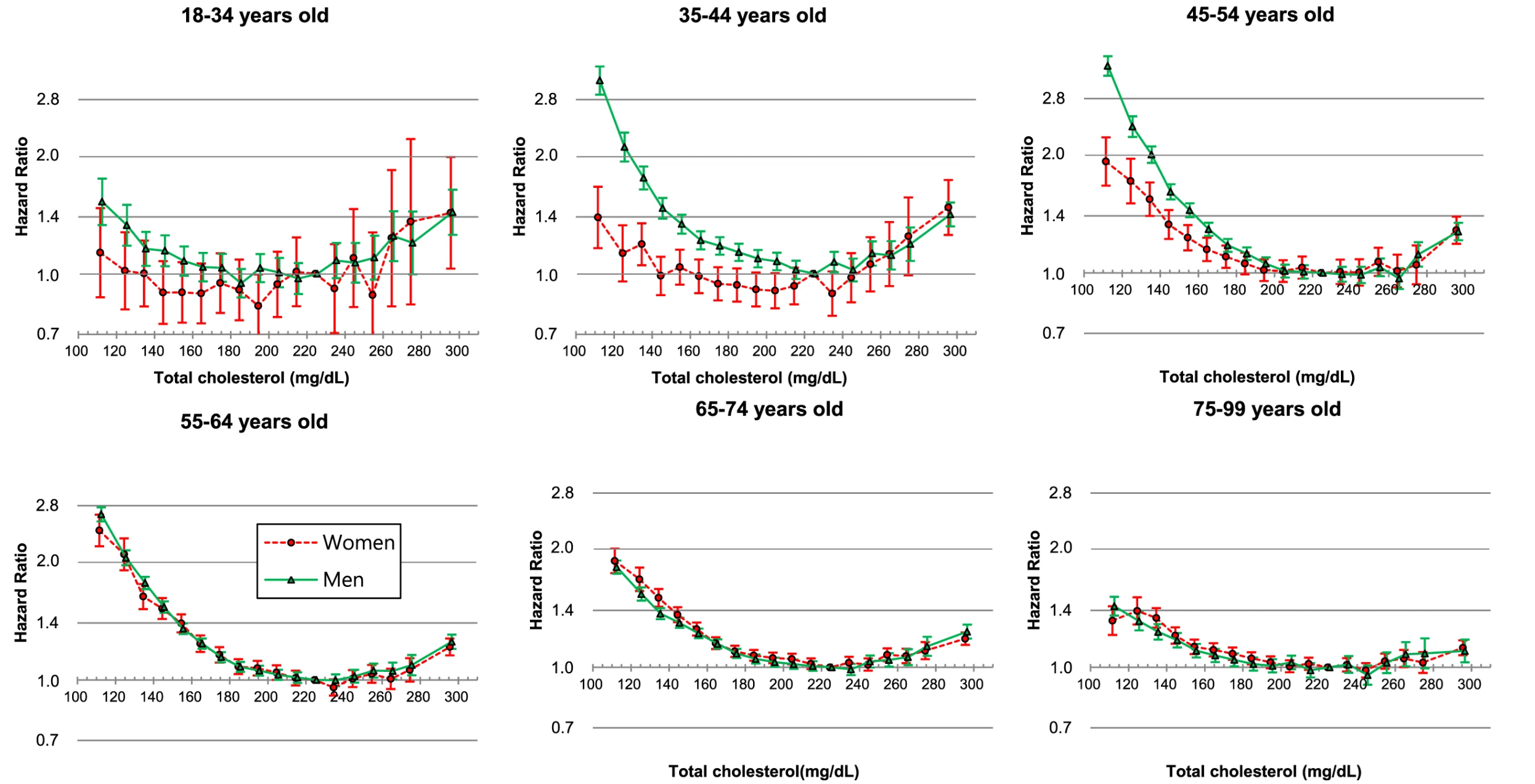
Comment:
Another in a line of studies showing that our concept of cholesterol is wrong when it comes to the outcomes that matter. This one is particularly interesting as it breaks it down by age, showing that as we get older, higher cholesterol becomes more protective.
Summary:
Based on this large observational study, the health risks associated with high total cholesterol (TC) decrease significantly as a person ages.
In younger adults (aged 18-44), higher TC levels ($\ge200$ mg/dL) were associated with the greatest increase in mortality risk. However, this association weakened with each subsequent age group, showing the lowest risk in the oldest participants (aged 75-99). This suggests that a higher cholesterol level is comparatively safer in an older individual than in a younger one.
It’s also important to note the study found a U-shaped curve in all age groups, meaning that mortality risk increased at both very low and very high TC levels. For most adults over age 45, the TC range associated with the lowest all-cause mortality was surprisingly high at 210-249 mg/dL, which is above the conventionally recommended “desirable” level of <200 mg/dL.
Clinical Bottom Line
This large Korean cohort study shows a strong U-shaped association between total cholesterol (TC) and all-cause mortality, which is significantly influenced by age. The key takeaway is that the risk associated with high cholesterol diminishes with advancing age. For most adults over 45, the lowest mortality risk was observed in the “borderline high” range of 210-249 mg/dL. Importantly, because this is an observational study, it identifies a strong association but cannot prove causation; these findings may be influenced by unmeasured confounding variables.
Results in Context
-
Main Results: The relationship between total cholesterol and all-cause mortality was a U-curve across all sex and age groups.
-
For TC levels $\ge200$ mg/dL, the link between higher cholesterol and increased mortality was strongest in the youngest adults and progressively weakened with age. For each 39 mg/dL (1 mmol/L) increase in TC, mortality risk increased by 14% in those aged 18-34, but only by 3% in those aged 75-99.
-
Conversely, for TC levels $<200$ mg/dL, lower cholesterol was associated with a significant increase in mortality. This inverse relationship was stronger than the positive association seen at high TC levels.
-
The optimal TC range for lowest mortality was 210-249 mg/dL for most age/sex groups, except for younger men and women where the optimal range was lowe
-
-
Definitions: A Hazard Ratio (HR) was used to estimate risk. An HR of 1.14 means there was a 14% increase in the risk of death in one group compared to a reference group over the study period. An HR below 1.0 indicates a reduced risk.
-
Participants: The study included 12,815,006 Korean adults who were followed for a mean of 10.5 years, during which 694,423 deaths occurred.
Assertive Critical Appraisal
-
Limitations & Bias (STROBE Framework): The primary limitation is the potential for confounding. Although the authors adjusted for many factors (smoking, BMI, blood pressure, etc.), unmeasured variables could still influence the results12. The authors correctly identify that not accounting for the use of lipid-lowering medications could lead to an underestimation of the true risk of high cholesterol13. The lack of data on cholesterol sub-fractions like LDL and HDL also limits the direct application of these findings to current clinical guidelines, which focus on these specific lipids.
-
Reporting Quality Assessment (STROBE): The study’s reporting is of high quality. The authors clearly described their large population, their methods for measurement, and, most critically for an observational study, their extensive efforts to address potential confounding variables through statistical adjustment in their multivariable models.
-
Applicability: The findings are from an ethnically homogeneous Korean population. As the authors note, the optimal cholesterol ranges and the magnitude of risk may differ in other ethnic populations that have different diets, genetic predispositions, and rates of heart disease. Therefore, caution is needed when generalizing these specific TC target ranges to a non-Korean patient population.
Research Objective
The study aimed to determine if the association between total cholesterol levels and all-cause mortality varied by sex and age and to identify the sex- and age-specific TC levels associated with the lowest mortality.
Study Design
This was a prospective cohort study using data from a national health screening program.
Setting and Participants
The study included 12,815,006 Korean adults, aged 18-99, who participated in routine health examinations between 2001 and 2004. They were followed for mortality until the end of 2013.
Bibliographic Data
-
Title: Total cholesterol and all-cause mortality by sex and age: a prospective cohort study among 12.8 million adults
-
Authors: Sang-Wook Yi, Jee-Jeon Yi, & Heechoul Ohrr
-
Journal: Scientific Reports
-
Year: 2019
-
DOI: 10.1038/s41598-018-38461-y
This AI-generated analysis is for informational and research purposes only and is not a substitute for professional medical advice, diagnosis, or treatment. Always seek the advice of a qualified health provider with any questions you may have regarding a medical condition.
Original Article:
Full text pdf: Total cholesterol and all-cause mortality by sex and age a prospective cohort study among 12.8 million adults
Open Access rights here
